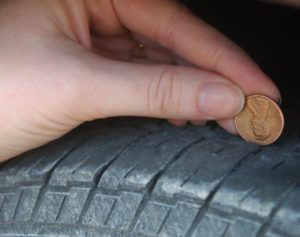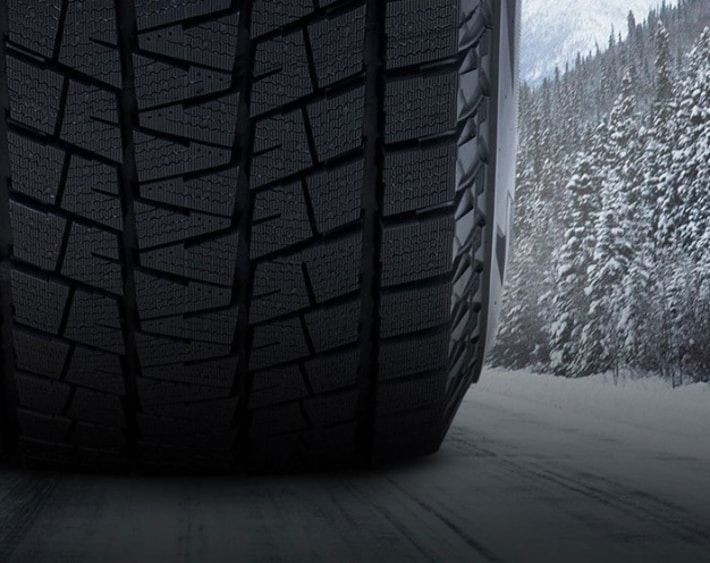Hitting the highway over the holiday season? Consider this: while you’re jamming out to "Jingle Bell Rock," only one part of your car will be touching the ground… your tires. That makes your tires one of your vehicle’s most critical safety features. On a holiday road trip, a minor tire issue could throw a major wrench in your seasonal plans, and even put you and your loved ones in danger.
Use the following tips to help prepare your tires for a safe holiday road trip.
1. Check your tire pressure.
Low tire pressure can put you, the driver, under pressure when you're on the road. In low temperatures, air molecules become less active, effectively "thinning" out the air both in and outside of your tires. For every 10°F drop in temperature, tires can lose 1-2 pounds per square inch (psi) of air pressure!
When a tire is underinflated, it can cause your vehicle to feel sluggish and slow to respond. That's why it's essential to check the tire pressure about every time you fill-up the gas tank. You want precise handling and ultimate control when driving in winter.
Find the right tire pressure for your make and model online or in your owner's manual. Many cars also have the suggested tire pressure printed on a sticker attached to the driver's side door jamb.
2. Properly inflate your tires.
Tire pressure too low? Time to inflate! Many gas stations have air machines that let you fill-up for a few quarters, but you can also use a handheld bike pump if you're in a pinch. You can also visit your nearest Firestone Complete Auto Care and we'll check and inflate your tires for free.
If you're inflating your tires on your own, beware of overinflation. Driving on overinflated tires can lead to poor handling, uneven tread wear, and an uncomfortable ride.
3. Check the condition of your tires.
You don't need to be a tire expert to determine whether your tires are in good condition. Tread wear patterns and tread depth can be checked in your driveway!
Tread wear patterns can give you plenty of clues about what might be wrong with your tires or other aspects of your car. For example, if you notice the inner or outer edge of a tire is more worn than the rest of the tread, the wheel alignment might be out of whack. Or, if the center of the tread is wearing down faster than the rest of the tire, your tire might be consistently overinflated. By contrast, the tires might be underinflated if you see excessive wear toward the edges of the tires.
As for tread depth, there's a simple, quick way to check it. All you need is a penny. Here's how the penny test works:
- Put your penny into a tread groove upside down, with theimage of Abraham Lincoln going in headfirst.
- Look at the portion of the penny that's visible. The tread is too shallow if you can see the top of Lincoln's head.
- Place the penny in several other grooves of the tires. Is the top of Lincoln's head still visible? If so, you might need new tires. Your tread depth probably isn't sufficient to give you enough grip on the road.
Excessive tread wear can compromise ride comfort and safety, and in many states, it may also result in a failed vehicle inspection or blocked registration! Even Colorado is now handing out tickets to drivers whose tires don’t meet its “weather-appropriate” standards! As more states move to follow suit, tire maintenance is more important than ever.
4. Have your tires rotated.
Tire rotation is the process of moving your tires from one position to another. The front tires might move to the back, or be moved from one side of the vehicle to the other. The exact re-positioning will depend on whether your vehicle is rear, four, or front wheel drive.
Regular tire rotations help prevent uneven tread wear, prolong the life of your tires, and boost fuel efficiency.
If the tread is uneven, it's harder for a tire to provide traction and grip, particularly on slick or gravel roads. Worse yet, you run the risk of tire failure or a blowout.
5. Get a wheel alignment.
Wheel alignment refers to an adjustment of a car’s suspension — the system that connects a vehicle to its wheels. It’s not an adjustment of the wheels or tires themselves.
Without proper wheel alignment, your car might pull to one side of the road, or your steering wheel may vibrate. Therefore, it's vital to get regular wheel alignments throughout the year. Such services can improve your car's handling and extend the life of your tires!
Need to get your tires checked out before hitting the road this holiday season? Stop by your local Firestone Complete Auto Care to get help with each of the to-do's on this list. Find your nearest location and let our techs get your tires ready for a merry holiday road trip.




